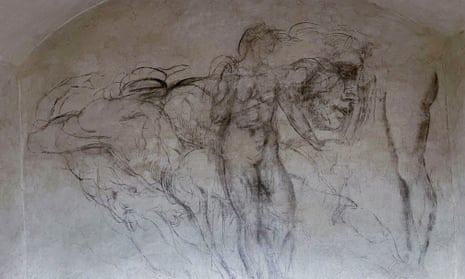Michelangelo Buonarroti left behind a trail of artistic marvels, including his statue of David and the sublime frescoes that adorn the ceiling of the Sistine Chapel.
Now a “secret” room in Florence whose walls are sketched with doodles that the Italian Renaissance master is believed to have created while evading a death sentence ordered by Pope Clement VII amid his falling out with the powerful Medici family is to officially open to the public for the first time.
Michelangelo is thought to have spent about two months hiding in the tiny chamber beneath the Medici Chapels in the Basilica of San Lorenzo in 1530, making dozens of drawings that are reminiscent of his previous works, including a drawing of Leda and the Swan, a painting produced during the same year that was later lost.
The existence of the charcoal and chalk drawings remained unknown until 1975 when Paolo Dal Poggetto, then the director of the Medici Chapels, one of five museums that make up the Bargello Museums, was searching for a suitable space to create a new exit for the museum.
He found a trapdoor underneath a wardrobe that led to the 10-metre-long, three-metre-wide room. The sketches were unveiled after the walls of the chamber, which until 1955 had been used to store slack coal before being sealed off for the next two decades, were stripped.
Paola D’Agostino, the director of the Bargello Museums, said it was as if the artist had wanted to produce a catalogue of his works, not knowing whether he would emerge from the chamber dead or alive.
“He drew things from the past as if he was taking a trip down memory lane … it was like having an album of his works,” D’Agostino said as she accompanied journalists on a visit to the room on Tuesday.
Other drawings recall some of the nude figures Michelangelo painted on the Sistine Chapel and one is similar to his David statue. Others reflect the figures adorning the Medici family tomb, created by Michelangelo and located in the New Sacristy above the chamber.
after newsletter promotion
It is widely believed that Michelangelo sought refuge in the room to hide from the Medicis, his former patrons, when the rulers returned to Florence after being banished into exile in 1527 by a popular revolt that the artist had joined.
During the family’s exile, Michelangelo served as supervisor of the city’s fortifications for the short-lived republican government. Pope Clement VII, a member of the Medici family, was furious with the artist and ordered his death. Giovan Battista Figiovanni, who was the prior of the Basilica of San Lorenzo where Michelangelo had been carrying out works, is thought to have located the hiding place.
The only source of light in the room comes from a tiny hatched window, from where Michelangelo could get a glimpse of the street above.
He was eventually pardoned by the Medicis and the sentence was lifted by the pope so that the artist could complete work on the Sistine Chapel and the Medici family tomb. Michelangelo left Florence for Rome in 1534.
Until now, the chamber, which opens to the public on 15 November, was mostly only accessible to art scholars. Visitors will be limited to four at a time to help preserve the space and its relics.
D’Agostino described the process of preparing the room for public view as a “time-consuming, constant and painstaking” job involving various professionals. She hopes that visitors will be as spellbound by the experience as she is.
“Even though I have been in the room so many times, I am still amazed by this mesmerising set of drawings,” she said.
